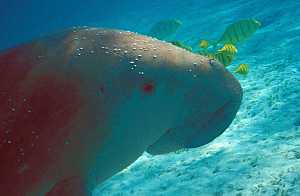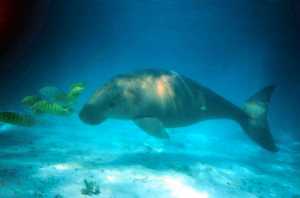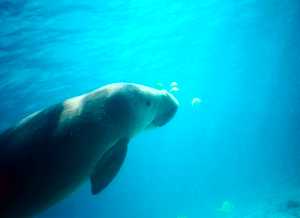Authorized extract from SirenianVoice Newsletter Winter 2002.
SirenianVoice is published electronically by Sirenian International, Inc.,
http://www.sirenian.org.
Nicky, the Friendly Dugong of Mantanani, Malaysia
By Gillian Elliott

For over two years we have been lucky to enjoy encounters with Nicky, a young male dugong who frequents the warm tropical waters around the Mantanani Islands, which are located in the South China Sea off the state of Sabah, Malaysia (Latitude 06º 42' N, Longitude 116º 20' E).
![]() Nicky gets his name from the small cut or "nick" in his left tail fluke, and this is the way we recognize him. He is a juvenile male of about 2 meters (6.5 feet) in length - he still has much growing to reach maturity (mature dugongs are up to 3 meters or 10 feet long). Usually we see Nicky alone, although there are other dugongs in the vicinity - often a mother and her calf. We have been very lucky to snorkel and SCUBA with Nicky cavorting nearby, even interacting closely with us, but he definitely calls the shots - and when he decides playtime is over, he is off with no way for us to catch up.
Nicky gets his name from the small cut or "nick" in his left tail fluke, and this is the way we recognize him. He is a juvenile male of about 2 meters (6.5 feet) in length - he still has much growing to reach maturity (mature dugongs are up to 3 meters or 10 feet long). Usually we see Nicky alone, although there are other dugongs in the vicinity - often a mother and her calf. We have been very lucky to snorkel and SCUBA with Nicky cavorting nearby, even interacting closely with us, but he definitely calls the shots - and when he decides playtime is over, he is off with no way for us to catch up.

![]() Sometimes we see Nicky feeding on the sea grasses (Halodule sp.) in the bay; feeding trails meander all over the seagrass bed. Dugongs are an important part of this ecosystem as demonstrated by the close association of "Golden Trevally" jacks in these photographs.
Sometimes we see Nicky feeding on the sea grasses (Halodule sp.) in the bay; feeding trails meander all over the seagrass bed. Dugongs are an important part of this ecosystem as demonstrated by the close association of "Golden Trevally" jacks in these photographs.
![]() Jacks and other fish often "shadow feed" on larger marine animals such as sharks, rays, and dugongs. "Shadow feeding" fish may benefit from this behavior in two ways: (1) they get protection from predators that won't approach the larger marine animals they are shadowing; and (2) it's easier to feed on small crabs, shrimps, and snails in sediments that have already been stirred up by dugongs or rays foraging in the seagrass beds. At other times, Nicky is observed interacting with the green turtles that feed in the same area. Usually we see him during the late afternoon toward sunset.
Jacks and other fish often "shadow feed" on larger marine animals such as sharks, rays, and dugongs. "Shadow feeding" fish may benefit from this behavior in two ways: (1) they get protection from predators that won't approach the larger marine animals they are shadowing; and (2) it's easier to feed on small crabs, shrimps, and snails in sediments that have already been stirred up by dugongs or rays foraging in the seagrass beds. At other times, Nicky is observed interacting with the green turtles that feed in the same area. Usually we see him during the late afternoon toward sunset.
![]() Near Mantanani Islands many local fishermen have seen dugongs for as long as they can remember, although the sightings are less frequent in recent times. Fortunately, the local people are not accustomed to eating dugongs so Nicky will not be hunted for his meat - we hope! Many Sabah villagers are superstitious about dugongs. They think they are mysterious, human-like, and some even consider them to be sea monsters. Although Nicky is relatively safe from hunting pressure here, he IS at risk from fishing activities such as trawling and gill netting, from being hit by boats, from hunting in other areas, and from coastal development.
Near Mantanani Islands many local fishermen have seen dugongs for as long as they can remember, although the sightings are less frequent in recent times. Fortunately, the local people are not accustomed to eating dugongs so Nicky will not be hunted for his meat - we hope! Many Sabah villagers are superstitious about dugongs. They think they are mysterious, human-like, and some even consider them to be sea monsters. Although Nicky is relatively safe from hunting pressure here, he IS at risk from fishing activities such as trawling and gill netting, from being hit by boats, from hunting in other areas, and from coastal development.
![]() Historically, dugongs were hunted for their meat - which is said to be more delicious than beef - in most of Malaysia. Other dugong parts were not wasted - the hide was used for leather, tusks were carved into knife handles, teeth were used to treat asthma, bones were used as medicines and talismans, and tears as a powerful love potion. Today, dugongs are a protected species in Malaysia, but poaching still occurs in some areas. Most dugong deaths in East Malaysia are due to accidental entanglements in fishing gear.
Historically, dugongs were hunted for their meat - which is said to be more delicious than beef - in most of Malaysia. Other dugong parts were not wasted - the hide was used for leather, tusks were carved into knife handles, teeth were used to treat asthma, bones were used as medicines and talismans, and tears as a powerful love potion. Today, dugongs are a protected species in Malaysia, but poaching still occurs in some areas. Most dugong deaths in East Malaysia are due to accidental entanglements in fishing gear.
![]() Southeast Asian is being rapidly developed; most of its human population already lives very near the coast. Coastal development often brings pollution and almost always causes loss of marine habitat - including seagrass beds that are essential to dugong conservation. Let us hope that Nicky's habitat can be preserved so he may reach a healthy maturity, find many mates and contribute his "friendly" genetic traits to a new generation of dugongs in this region of South East Asia.
Southeast Asian is being rapidly developed; most of its human population already lives very near the coast. Coastal development often brings pollution and almost always causes loss of marine habitat - including seagrass beds that are essential to dugong conservation. Let us hope that Nicky's habitat can be preserved so he may reach a healthy maturity, find many mates and contribute his "friendly" genetic traits to a new generation of dugongs in this region of South East Asia.
Text and Photos: Gillian Elliott
A recent video of Nicky can be seen on YOUTUBE.
Please have a look at : http://www.youtube.com/watch?v=YZ_lAwT0tb0
For information about travel to this area, visit http://www.bornsea.com/mantanani/. Gillian Elliott is a marine biologist working in the South China Sea near Kota Kinabalu, Sabah, Malaysia, and a Participating Member of Sirenian International, Inc. http://www.sirenian.org. Caryn Self-Sullivan contributed to this article using information from the UNEP/IUCN Dugong Status Report and Action Plans for Countries and Territories, UNEP/DEWA/RS.02.1, ISBN 92-807-2130-5, which can be accessed online at http://www.tesag.jcu.edu.au/dugong/.